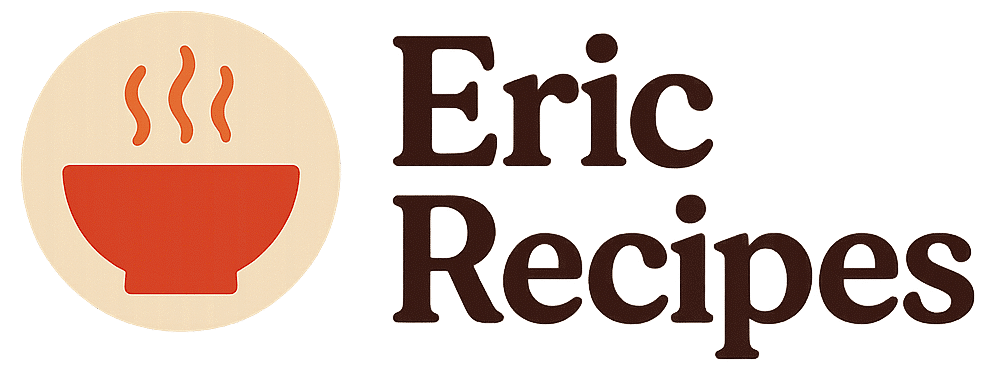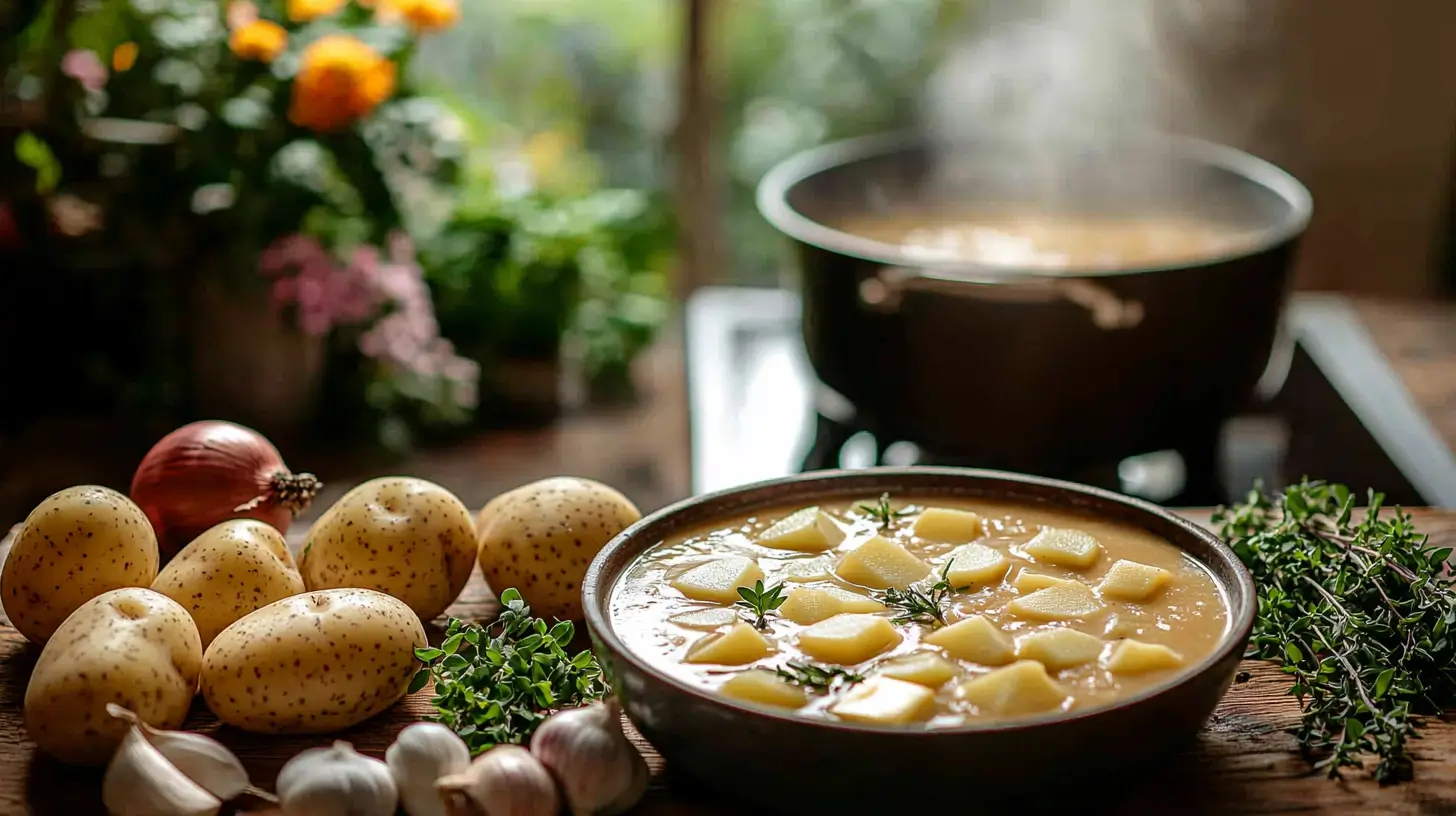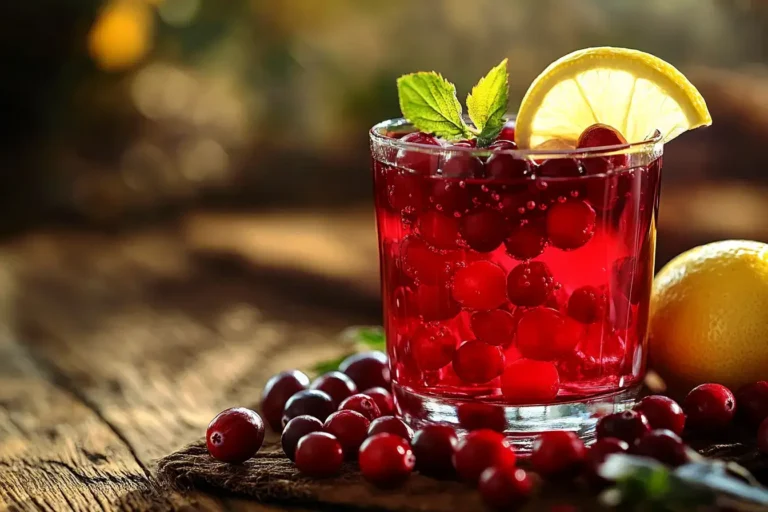Why Does My Potato Soup Have No Flavor? Tips to Fix It!
Potato soup is a comforting, hearty dish that’s loved by many, but there’s nothing more disappointing than taking a spoonful only to find it bland and lacking in flavor. If you’ve ever wondered, “Why does my potato soup have no flavor?” you’re not alone. This comprehensive guide will delve into the common pitfalls that can lead to flavorless potato soup and offer expert tips and tricks to elevate your dish into something truly delicious.
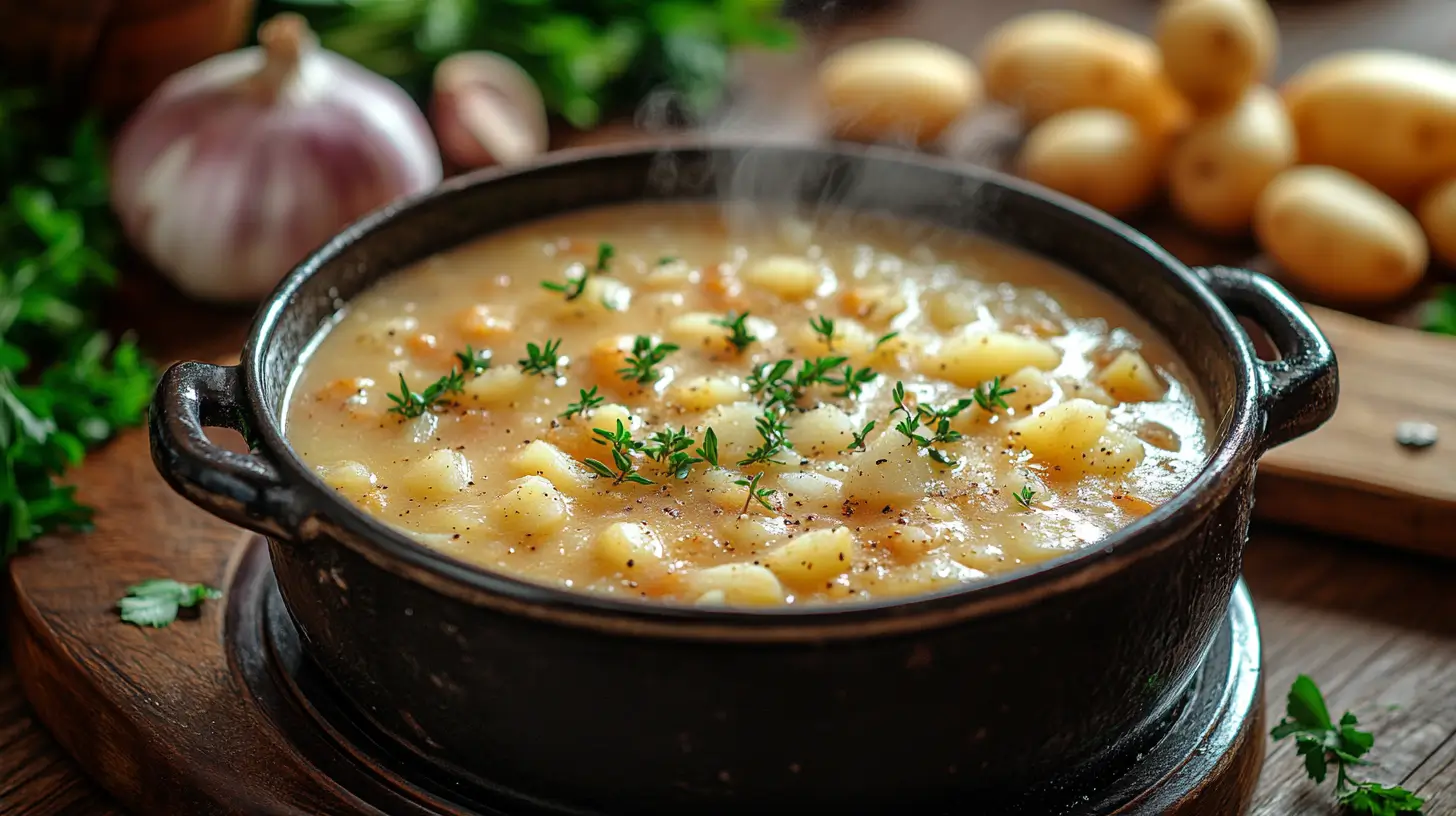
Table of Contents
- Introduction
- Common Reasons Why Potato Soup Lacks Flavor
- Ingredients to Enhance Potato Soup Flavor
- Steps to Improve the Flavor of Your Potato Soup
- Tips for a More Flavorful Potato Soup
- Recipe Adjustments for Dietary Needs in Potato Soup
- Serving Suggestions for Potato Soup
- Nutritional Benefits of Potato Soup
- Cultural Significance and History of Potato Soup
- Choosing the Right Potatoes for Soup
- Essential Kitchen Tools for Cooking Potato Soup
- Storing and Reheating Your Potato Soup
- Frequently Asked Questions (FAQs) About Potato Soup
- Conclusion
Introduction
There’s nothing quite like a warm, creamy bowl of potato soup on a chilly day. It’s a dish that evokes nostalgia, comfort, and simplicity. Yet, despite its straightforward nature, many home cooks find themselves disappointed by their potato soup, wondering, “Why does my potato soup have no flavor?” This common issue can turn what should be a delightful meal into a bland experience.
In this guide, we’ll explore why potato soup can sometimes fall flat and how to fix it. From selecting the right ingredients to mastering the cooking process, you’ll learn how to infuse your soup with robust flavors that will make each spoonful satisfying. Whether you’re a beginner in the kitchen or a seasoned cook looking to perfect your recipe, these expert tips will help you create a potato soup that bursts with flavor.
Common Reasons Why Potato Soup Lacks Flavor
Insufficient Seasoning in Potato Soup
One of the most common reasons potato soup lacks flavor is insufficient seasoning. Potatoes are naturally bland, so they need a good amount of salt and pepper to bring out their taste. Skimping on seasoning, especially at the start of cooking, can leave your soup underwhelming.
Underdeveloped Flavors in Potato Soup
Potato soup relies heavily on the development of flavors, which requires time. Rushing the cooking process can prevent the ingredients from melding together properly, resulting in a soup that tastes flat. Simmering the soup for a longer period allows the flavors to concentrate and deepen.
Using Low-Quality Ingredients in Potato Soup
The base of your potato soup, often consisting of broth or stock, plays a crucial role in determining the overall flavor. Using a low-quality or watery broth can lead to a soup that’s weak and lacking in depth.
Lack of Fat Content for Flavorful Potato Soup
Fat is a carrier of flavor and helps to create a rich, satisfying mouthfeel. If your potato soup is made with only water or skim milk, it may be lacking in the fat necessary to make it truly flavorful. Adding ingredients like butter, cream, or cheese can enhance the richness and taste.
Choosing the Right Potatoes for Flavorful Soup
Not all potatoes are created equal. Using old, starchy, or low-flavor varieties can result in a soup that lacks the robust potato flavor you’re aiming for. Choosing the right type of potato is essential to achieving a flavorful soup.
Ingredients to Enhance Potato Soup Flavor
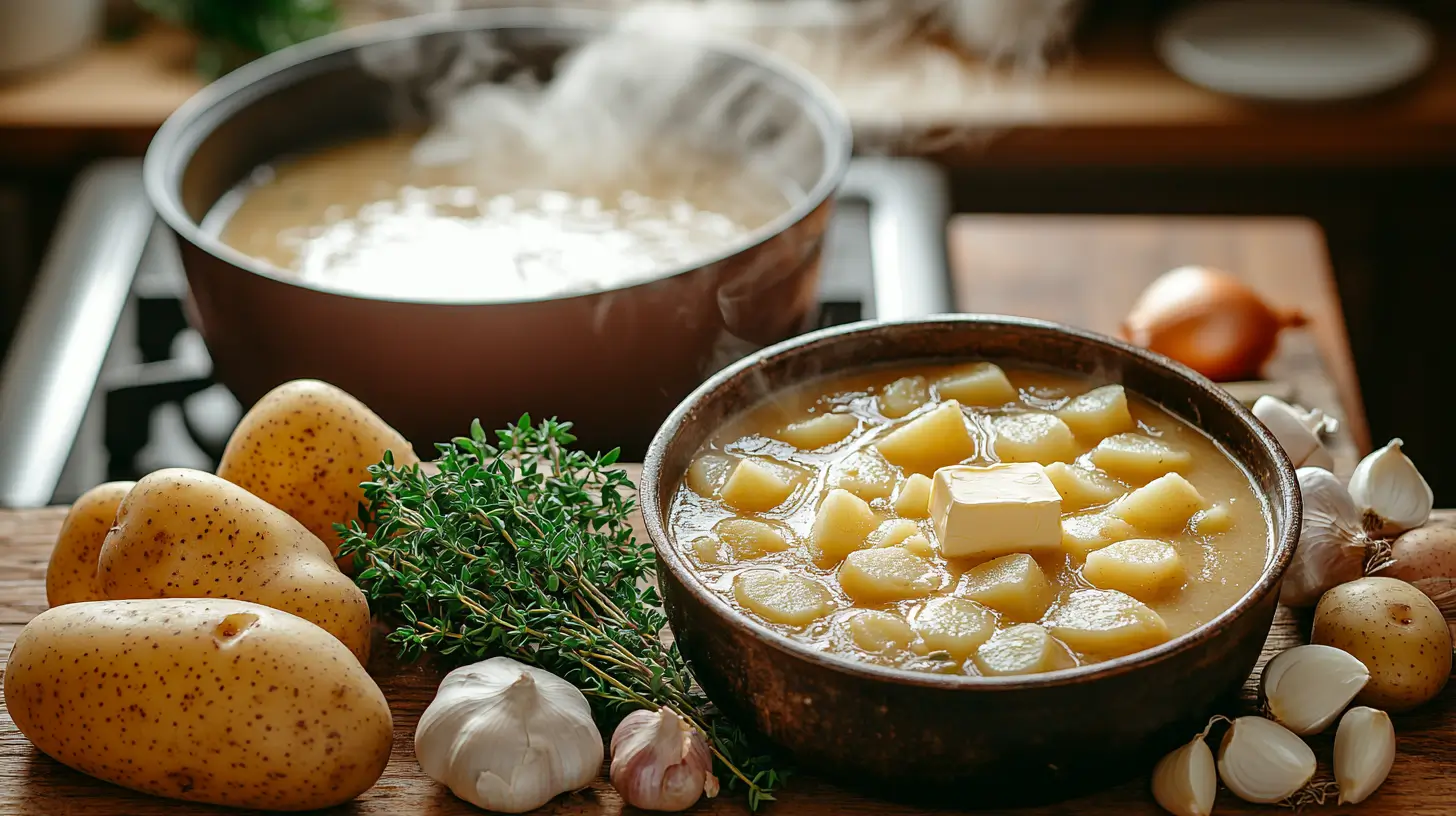
The Importance of Aromatics in Potato Soup
Aromatics like onions, garlic, leeks, and celery are essential for adding depth to your soup. Sautéing these ingredients in butter or olive oil before adding them to the soup can enhance their flavors.
Choosing High-Quality Broth for Potato Soup
Using a high-quality chicken, vegetable, or beef broth can make a significant difference. Homemade broth is always best, but if using store-bought, choose a low-sodium option so you can control the salt levels.
Seasoning Potato Soup for Maximum Flavor
Salt and pepper are your basic seasonings, but don’t stop there. Fresh or dried herbs like thyme, rosemary, or bay leaves can add complexity. A splash of soy sauce or Worcestershire sauce can introduce umami, while a dash of acid, like lemon juice or vinegar, can brighten the flavors.
Adding Fats to Enhance Potato Soup Flavor
Butter, cream, or even a good olive oil can add richness and carry the flavors throughout the soup. Cheese, such as cheddar or Parmesan, can also add a savory element.
Extra Flavor Boosters for Potato Soup
Consider adding cooked bacon, ham, or sausage for a smoky, meaty flavor. For a vegetarian option, roasted vegetables or sautéed mushrooms can add umami depth.
Steps to Improve the Flavor of Your Potato Soup
Start with Aromatics to Build Flavor
Begin by sautéing onions, garlic, and celery in butter or olive oil until they are soft and translucent. This step builds the foundation of your soup’s flavor. If you’re using leeks, be sure to clean them thoroughly before chopping, as they can trap dirt between their layers.
Selecting and Preparing Potatoes for Soup
Cut your potatoes into uniform pieces to ensure even cooking. Depending on the texture you prefer, you can leave the skins on for a rustic feel or peel them for a smoother soup. Russet potatoes will break down more during cooking, creating a creamier texture, while Yukon Golds will hold their shape better.
Using Quality Broth to Enhance Soup Flavor
Add your broth or stock to the pot, making sure it’s of good quality. If you’re using store-bought, taste it first and adjust the seasoning accordingly. Bring the soup to a boil, then reduce the heat to a simmer.
Seasoning Throughout the Cooking Process
Season your soup with salt and pepper early in the cooking process. As the soup simmers, taste it periodically and adjust the seasoning. Adding herbs like thyme or bay leaves at this stage allows them to infuse the soup with their flavors.
Simmering the Soup for Rich, Developed Flavors
Allow your soup to simmer for at least 30 minutes. This gives the flavors time to meld together and intensify. If you have the time, simmering for an hour or more can make the soup even more flavorful.
Adding Creaminess for Rich Potato Soup
For a richer soup, stir in cream, half-and-half, or a dollop of sour cream towards the end of cooking. Be careful not to boil the soup after adding dairy, as it can curdle. Alternatively, purée a portion of the soup and stir it back in to thicken the texture.
Finishing Touches to Boost Potato Soup Flavor
Just before serving, taste the soup one last time and adjust the seasoning. A splash of vinegar, a squeeze of lemon juice, or a sprinkle of fresh herbs can brighten the flavors. If desired, stir in some grated cheese for an extra savory touch.
Tips for a More Flavorful Potato Soup
Building Layers of Flavor in Potato Soup
Don’t rush the cooking process. Taking the time to sauté your aromatics, simmer the soup slowly, and season as you go will result in a more flavorful dish. Each step adds a layer of flavor that contributes to the overall taste.
Proper Seasoning Techniques for Potato Soup
Potatoes can absorb a lot of salt, so don’t be shy when seasoning your soup. Taste frequently and adjust the salt levels to your preference. If you’re worried about over-salting, add a little at a time and build up to the desired level.
Enhancing Soup Flavor with Fresh Herbs
Fresh herbs can make a significant difference in flavor. If possible, add them towards the end of cooking to preserve their bright, aromatic qualities. Dried herbs are more concentrated and can be added earlier in the cooking process.
Adding a Touch of Acid to Balance Potato Soup
A small amount of acid can balance the richness of potato soup. Try adding a splash of white wine, a teaspoon of vinegar, or a squeeze of lemon juice. This will enhance the flavors and prevent the soup from tasting too heavy.
Experimenting with Spices in Potato Soup
For a different twist, consider adding a pinch of nutmeg, smoked paprika, or cayenne pepper. These spices can add warmth and complexity to your soup. Just be careful not to overpower the delicate potato flavor.
Recipe Adjustments for Dietary Needs in Potato Soup
Creamy Vegan Potato Soup Options
Replace the dairy with coconut milk or a cashew cream for a rich, vegan-friendly soup. Use vegetable broth and season with nutritional yeast for a cheesy, umami flavor without the cheese.
Cheesy Bacon Potato Soup Recipe
Add cooked bacon bits and shredded cheddar cheese to the soup. Stir the cheese in at the end until melted and creamy. This version is indulgent and perfect for those who love a heartier, more decadent soup.
Spicy Potato Soup Variations
For those who enjoy a kick, add chopped jalapeños or a dash of hot sauce. You can also sprinkle in some red pepper flakes or smoked paprika for a smoky, spicy twist.
Gluten-Free Potato Soup Adjustments
Ensure all ingredients, including broth and seasonings, are gluten-free. Use cornstarch or a gluten-free flour blend to thicken the soup if needed. Most potato soups are naturally gluten-free, but it’s always good to check your labels.
Serving Suggestions for Potato Soup
Pairing Potato Soup with Complementary Sides
Potato soup pairs wonderfully with crusty bread or a side salad. A slice of garlic bread or a warm, buttery roll can complement the creaminess of the soup. For a lighter option, a fresh green salad with a tangy vinaigrette can balance the richness.
Presentation Tips for Serving Potato Soup
Serve your potato soup in a deep bowl, garnished with fresh herbs like chives, parsley, or dill. A dollop of sour cream or a sprinkle of grated cheese can add an appealing visual and flavor boost. For a rustic touch, consider serving the soup in a bread bowl.
Nutritional Benefits of Potato Soup
Health Benefits of Eating Potato Soup
Potato soup can be a good source of vitamins and minerals, particularly when made with nutrient-rich ingredients like potatoes, onions, and broth. Potatoes are high in potassium, vitamin C, and fiber, which can contribute to a healthy diet when consumed in moderation.
Cultural Significance and History of Potato Soup
The Historical Background of Potato Soup
Potato soup has a rich history that dates back centuries. Originating in Europe, particularly in regions like Ireland and Germany, potato soup was a staple for many due to the affordability and availability of potatoes. Over time, it has evolved into various regional versions, from creamy French-style soups to chunky, hearty Irish stews. Each culture has added its own twist, making potato soup a diverse and beloved dish around the world.
Choosing the Right Potatoes for Soup
Best Potato Varieties for Potato Soup
Potatoes are incredibly versatile, with different varieties offering unique flavors and textures. Russet potatoes, with their high starch content, are perfect for creating a creamy soup. Yukon Golds, known for their buttery flavor, hold up well in soups and add richness. Red potatoes retain their shape, making them ideal for chunkier soups.
Proper Selection and Storage of Potatoes
Choose firm, smooth potatoes without any green spots or sprouting eyes. Store them in a cool, dark place with good ventilation to keep them fresh for longer. Avoid refrigerating potatoes, as this can cause the starches to convert to sugars, affecting both taste and texture.
Essential Kitchen Tools for Cooking Potato Soup
Must-Have Equipment for Potato Soup
To make the best potato soup, you’ll need a few essential kitchen tools:
- Heavy-bottomed pot or Dutch oven: For even cooking and simmering.
- Sharp knife: To easily cut through the potatoes and other vegetables.
- Blender or immersion blender: For puréeing the soup to your desired consistency.
- Wooden spoon: For stirring and preventing the soup from sticking to the bottom of the pot.
Alternatives to Common Kitchen Tools
If you don’t have an immersion blender, you can use a regular blender. Just be sure to blend in batches and avoid overfilling to prevent spills. A potato masher can also work if you prefer a chunkier texture.
Storing and Reheating Your Potato Soup
Proper Storage Techniques for Potato Soup
Store leftover potato soup in an airtight container in the refrigerator for up to 3-4 days. For longer storage, freeze the soup in portions, leaving room for expansion, for up to 3 months.
Best Methods for Reheating Potato Soup
Reheat potato soup on the stovetop over low heat, stirring occasionally to prevent it from sticking. If the soup has thickened too much in the fridge or freezer, add a splash of broth or milk to thin it out. Avoid using the microwave, as it can heat the soup unevenly.
Frequently Asked Questions (FAQs) About Potato Soup
How Can I Thicken My Potato Soup?
If your soup is too thin, you can thicken it by blending a portion of the soup and stirring it back in. Alternatively, add a slurry of cornstarch and water, or simply let the soup simmer uncovered to reduce and thicken naturally.
What If My Potato Soup Is Too Salty?
To fix an overly salty soup, try adding more potatoes or other unsalted ingredients like cream or milk. You can also balance the saltiness by adding a bit of sugar, lemon juice, or vinegar.
Can I Make Potato Soup Ahead of Time?
Yes, potato soup is a great make-ahead dish. In fact, it often tastes better the next day as the flavors continue to develop. Just be sure to store it properly and reheat gently to preserve its texture and taste.
Why Did My Potato Soup Turn Gritty?
Grittiness in potato soup can result from overcooking the potatoes or using a blender at too high a speed, which can cause the starches to break down unevenly. To avoid this, cook the potatoes just until tender and blend the soup gently.
Can I Use Other Vegetables in My Potato Soup?
Absolutely! Adding vegetables like carrots, celery, leeks, or corn can enhance the flavor and texture of your potato soup. Just be sure to adjust the cooking time as needed for different vegetables.
Conclusion
Creating a flavorful potato soup doesn’t have to be a challenge. By understanding the common issues that lead to bland soup and following these expert tips, you can transform your dish into something truly delicious. Remember to season well, take your time to develop flavors, and don’t be afraid to experiment with different ingredients and variations. Whether you’re serving it as a cozy family dinner or a special meal for guests, a well-made potato soup is always a crowd-pleaser.
So, the next time you find yourself asking, “Why does my potato soup have no flavor?” you’ll have all the tools and knowledge you need to fix it. Happy cooking!
